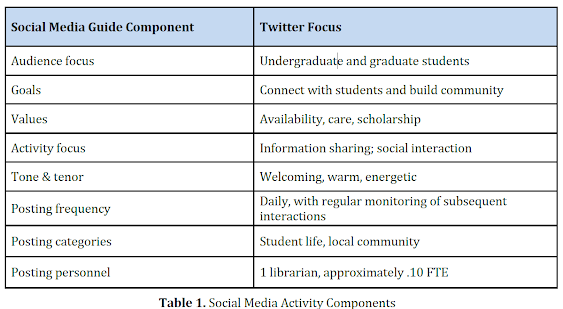Weep 9: Article Summary " Building Library Community Through Social Media"
This paper details how an academic
library leveraged Twitter to foster community. While existing literature
predominantly addresses social media's marketing role, this research emphasizes
its capacity for community-building. The university library formed a social
media group and implemented a guide to cultivate a purposeful, engaging, and
interactive online presence. Quantitative analysis revealed a significant
rise in Twitter followers and interactions, highlighting social media's
potential to strengthen the library's ties with academic communities.
This study is pivotal for
understanding social media's impact on academic libraries, particularly fostering
user communities. Emphasizing strategy, personality, and interaction, the
research provides practical guidance for libraries aiming to enhance their
social media presence. Its detailed methodology and robust quantitative data
make it an indispensable resource for libraries transitioning from traditional
marketing approaches to more engagement-focused social media strategies.
The article contributes to
research on how institutions, including libraries, utilize social media to
establish and nurture communities. It offers insights into strategic social
media use beyond conventional marketing, focusing on engagement and interactive
communication in digital realms. These findings are instrumental in shaping
effective practices for community engagement through social media across
various institutional contexts.
Methodology
In May 2012, Montana State University Library
established a Social Media Group (SMG) to direct our social media efforts. This
marked a significant change and was pivotal in developing a structured approach
to social media. The SMG aimed to engage students on Twitter, comprising three
librarians and one staff member, creating a social media guide with eight key
components to shape our activities. This guide outlines eight principal
components of social media activity in the following Table 1.
Results
The paper presents several key results:
1. Increased Engagement: After forming the Social Media Group (SMG) and implementing their social media guide, there was a notable increase in Twitter followers and interactions.
2. Shift in Strategy: The transition from automated to personalized social media posts led to a more engaging and personality-driven Twitter presence for the university library.
3. Quantitative Analysis: The study used quantitative methods such as user type analysis, action-object mapping, and interaction analysis to assess the impact of their social media strategy.
4. Community Building: Findings suggest that strategic use of social media can foster norms of reciprocity and trust, enhancing community ties within academic institutions.
Overall, the research underscores the effectiveness of
intentional social media strategies in promoting community engagement in
academic library settings.
Reference: Young, S. W. H., & Rossmann, D. (2015). Building library community through social media. Information technology and libraries, 34(1), 20-37.



Comments
Post a Comment